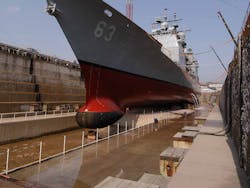Lockheed Martin to build anti-submarine warfare (ASW) systems, hull-mounted sonar, for counter-mine warfare
WASHINGTON – Undersea warfare experts at Lockheed Martin Corp. will provide the U.S. Navy with AN/SQQ-89A(V)15 anti-submarine warfare (ASW) systems and hull-mounted sonar transmitters for surface warships under terms of a $80.2 million order announced Tuesday.
Officials of the Naval Sea Systems Command in Washington are asking the Lockheed Martin Corp. Rotary and Mission Systems segment in Manassas, Va., to provide technical insertion-20 (TI-20) AN/SQQ-89A(V)15 surface ship undersea warfare combat systems and AN/SQS-53C hull-mounted sonar transmitter infrastructure shipset hardware.
The AN/SQQ-89A(V)15 is an undersea combat system that uses active and passive sonar to enable Navy Arleigh Burke-class destroyers and Ticonderoga-class cruisers to search for, detect, classify, localize, and track underwater contacts; and to attack or avoid enemy submarines, floating, tethered, or bottom-attacked mines, and torpedoes. This contract combines purchases for the U.S. Navy and Australia.
The counter-mine and anti-torpedo system provides multi-sensor track correlation and target track management control, and forwards data to the ship’s weapons and decision-support systems. The AN/SQQ-89A(V)15 works together with the ship's active and passive hull sonar, multi-function towed array, sonobuoy processing, torpedo alerts, fire-control system, sensor performance predictions, embedded operator, and team training systems.
Related: New ship takes lead in countermine and anti-submarine warfare
The AN/SQQ-89A(V)15 has an open-systems electronics architecture to accommodate system upgrades, and makes the most of data accessibility and system modules, Lockheed Martin officials say. Its software application programs are isolated from hardware with open middleware to render applications processor-independent.
The system uses POSIX-compliant system calls and Motif and X-compliant display service calls. Symmetric multi-processors (SMPs) using Linux-based processing handle signal, data, display, and interface processing.
Virtual Network Computing (VNC) enables rapid re-allocation of operator console displays to suit the tactical situation, Lockheed Martin officials say.
Recent and planned upgrades to the AN/SQQ-89A(V)15 include improved automated torpedo detection, sonar performance prediction, advanced active sonar processing, re-designed active displays to reduce operator loading, and integrated training and logistics.
The AN/SQS-53 hull mounted sonar array, meanwhile, is a large bulb-like structure built into the bows below the water line of U.S. Navy Arleigh Burke-class destroyers, Ticonderoga-class cruisers, and Japanese navy Kongo-class destroyers. The AN/SQS-53 is a component of AN/SQQ-89(V) acoustic sonar weapons system for surface warships.
The surface ship AN/SQS-53 is a computer-controlled surface-ship sonar that has active and passive operating capabilities providing precise information for ASW weapons control and guidance.
The AN/SQS-53C, the latest version of this hull-mounted sonar system, retains the transducer assembly from either the AN/SQS-53A and 53B, yet provides greater range and detection capability with only half of the electronics footprint and less weight than earlier versions.
Constructed in standard electronic modules, the AN/SQS-53C is an all-digital system that provides apparent range, bearing, and true bearing of submarine contacts with active sonar and true bearing of contacts with passive sonar.
Active sonar transmits a ping to bounce sound waves off the hulls of submarines. Passive sonar means simply listening for the sounds of submarines and surface vessels. This system is the basic sonar watch-standers tool to keep an eye on all ship traffic; the system often detects other surface ships at greater ranges than can most radar systems.
The AN/SQS-53 simultaneously can detect, identify, and track several different targets, and interfaces with the host vessel's digital computers. It has three active modes of operation: surface duet, bottom bounce, and convergence zone. It also can ping off buoys to pinpoint its own location in foreign ports.
On this order Lockheed Martin will do the work in Lemont Furnace, Pa.; Clearwater, Fla.; Syracuse and Owego, N.Y.; and Manassas, Va., and should be finished by June 2026.
For more information contact Lockheed Martin Rotary and Mission Systems online at www.lockheedmartin.com, or Naval Sea Systems Command at www.navsea.navy.mil.
About the Author
John Keller
Editor-in-Chief
John Keller is the Editor-in-Chief, Military & Aerospace Electronics Magazine--provides extensive coverage and analysis of enabling electronics and optoelectronic technologies in military, space and commercial aviation applications. John has been a member of the Military & Aerospace Electronics staff since 1989 and chief editor since 1995.
